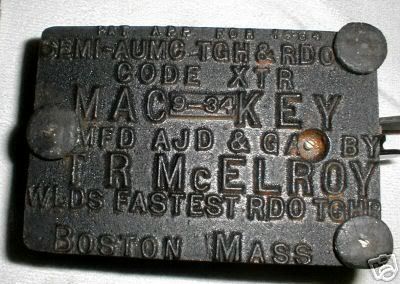 I told myself I wasn't going to buy anything else on eBay — unless I saw “a deal.” Meet my “deals,” below.
I told myself I wasn't going to buy anything else on eBay — unless I saw “a deal.” Meet my “deals,” below.
1936 McElroy MAC KEY STANDARD. Bidding on this key had stalled early in the week — a sure sign that half a dozen people are waiting to try to snipe the thing in the auction's closing seconds.
The 1936 Mac Key is complete and in original condition with the exception of the weights. I have brass round bar stock and can make replacement weights for Mac Keys as needed, so that's not a problem.
You have to admire Ted McElroy — here's a man who made his living as a crack telegrapher, and at the age of 33 started his own company to manufacture keys of his own design.
The 1936 key is a slightly refined version of his first design, the 1934 model. The first couple of years, Mac refined the way the dash and dot contacts were attached to the base of the key. The first incarnation of the key had contacts that weren't as rock solid as Mac wanted, so the design evolved.
The 1936 key retained the rather complicated two-hinge keying lever arrangement for the dash lever. It works fine, but its much more complicated than the way Vibroplex was doing it at that time. Perhaps Vibroplex's patents prevented him from adopting a similar system.
The 1934-36 keys were designed so they could be turned placed on their left side and used as a straight key. The key was equipped with a small wire clip on the damper than would clip the keying lever tight to the damper so it wouldn't move when placed on its side. It made for a rather odd straight key, but few other bugs offered that kind of versatility. I don't know if there was much need for that feature since Mac dropped it after the 1936 model.
The 1934-36 keys had Mac's proclamation cast into the bottom of the key:
SEMI-AUMC TGH & RDO
CODE XTR
MAC KEY
MFD AND GAD BY
T R MCELROY
WLDS FASTEST RDO TGHR
BOSTOM MASS

Or translated, it reads: “Patent applied for 1934; Semi-automatic telegraph and radio code transmitter; MAC KEY; manufactured and guaranteed by T.R. McElroy; World's Fastest Radio Telegrapher; Boston, Mass.”
By comparison, the 1938 Mac Key DeLuxe I'm using in the shack at present represents a higher degree of refinement on the earlier Mac Key design. The 1936 key appears to have everything it will need to be an operable key, so look for my blatherings about it in the future — perhaps in time for Straight Key Night.
MAC NUMBER 2. What is this, McElroy night?? For my blog, it certainly is. The second key I scored is a mint condition Telegraph Apparatus Company bug, otherwise known as the “Hole-In-The-Wall” bug.
This World War II-era key was produced in Chicago. I have several of these, but my only version like this one is nowhere near as nice as the one I won on eBay. It never fails to amaze me how differently each style of key operates. They all do the same job, but the feel of the key can vary a great deal.
The TAC bug seems to take a lot effort to operate it well, even more so that its more massive, earlier McElroy brethren. I have a DeLuxe version of the TAC bug that — for whatever reason — is the only TAC bug that I've used that doesn't require you to manhandle it. It's not that they're impossible or uncomfortable to use, but switching from one bug to another requires a little relearning.
My theory is that the difference is the balance and leverage of the keying lever. While it appears bulky and huge, the Mac Key's keying lever seems to handle the bulk well. The TAC bug keying lever seems very long. I've never measured either, perhaps its just my perception.
Anyhow, I'm going to likely swap the best parts around on my existing TAC bug and then sell the one in lesser condition. There's another TAC bug on eBay that's been converted into a (** shudder! **) paddle. I might buy that monstrosity and simply put it out of its misery! Ugh!
SPEAKING OF UGLY DUCKLINGS. Another key I picked up on eBay is more a collection of parts than a complete key. This key is a very early Speed-X key, the earliest of which carried no ID tag or serial number. I have a key with a crappy base, but is perfect otherwise. If I can, I would like to snag that early Speed-X simply for its base. That's iffy at best, but we'll see. I'm not sure there's more than a dozen folks who give a crap about such minute stuff. Who really cares, and what does it matter? Good question, but you can ask that of anyone's hobby … right??! Here's hoping so.
73 es CUL …. de KY4Z … dit dit ….
